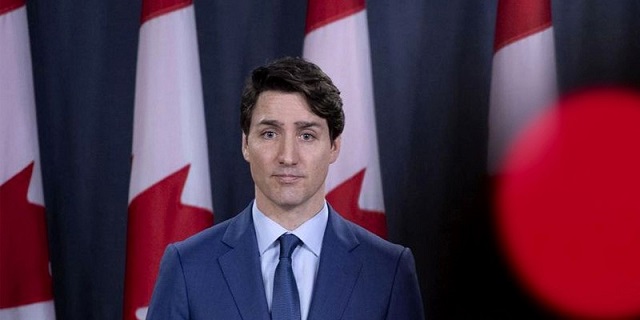Business
Federal government ratchets up ‘climate’ propaganda

From the Fraser Institute
In the face of resistance from provinces to its anti-fossil fuel agenda, and having endured several setbacks in the federal courts over some of its signature environmental policies, the Trudeau government has rolled out a new propaganda campaign to build greater support for its climate and energy policies.
According to the government’s new “Raising the Bar” campaign, manmade climate change has quickly evolved from a future threat to a real-time crisis where we’re experiencing more “wildfires, floods, and droughts” that affect “our economy, our infrastructure, our health, and our overall well-being.”
But is this true? Our government, which regularly claims to follow evidence-based policy, doesn’t provide much evidence to back up these claims—probably because there isn’t a lot of strong evidence that we’re seeing dramatic changes in extreme weather events.
Take wildfires, for example. In reality, wildfires in Canada have been declining in number, extent and severity over the last four decades, even as the overall climate has warmed (which it has, undeniably). More broadly, according to the United Nations Intergovernmental Panel on Climate Change (IPCC), it’s only “likely” that heavy rainfall events have increased in North America since 1950, and the IPCC only has “medium confidence” that droughts have worsened since 1950.
Nonetheless, despite a relative paucity of data indicating worsening extreme weather events in Canada, we must “Raise the Bar” and “tackle the climate crisis” by essentially doing less of just about everything Canadians want to do.
The Trudeau government’s new campaign includes a slick video showing how Canadians are “Stepping Up” to the government’s ideas of the good life. We meet Charles, who now takes the bus twice a week, and Megan, who swapped her trusty gas-powered leaf blower for an electric one. Jade and Amina have taken government subsidies to swap out their reliable gas heating system for an electric heat pump. And the Nguyen family now dries its clothes on clotheslines. Of course, the video does not reveal that some of these virtuous acts will be fairly horrible in the cold winters that grip most of the country. One wonders how many tax dollars went to fund this little paean to Canadians who follow government dictates. (Interestingly, when the government posted the video on YouTube, it disabled the comments so Canadians can’t, well, comment.)
But the propaganda doesn’t stop with gentle nudging. On the website, Canadians are told to use less energy, less water, buy less new clothing, travel less, and eat less meat while eating more plant matter (ironically, the government’s efforts to reduce nitrogen fertilizer will make plant matter more expensive and less available).
One might dismiss the latest climate propaganda campaign as just another government Public Service Announcement intended to help people live more climate-healthy and mindful lives, but that would be a mistake. Because this propaganda campaign doesn’t simply encourage people to get more exercise or eat less junk food, it seeks to create a public mindset that will convince Canadians to accept a raft of coercive regulations—such as the hard cap on greenhouse gas emissions or restrictions on fuel tankers and pipelines—which prevent the development of oil and gas resources across Western Canada and restrict the economy.
Rather than making our lives better, as the “Stepping Up” video suggests, the coercive regulatory regime that underpins these new ways of living will, in fact, leave Canadians less prosperous and force them to pay more for less of just about everything.
Author:
Business
RFK Jr. says Hep B vaccine is linked to 1,135% higher autism rate

From LifeSiteNews
By Matt Lamb
They got rid of all the older children essentially and just had younger children who were too young to be diagnosed and they stratified that, stratified the data
The Centers for Disease Control and Prevention (CDC) found newborn babies who received the Hepatitis B vaccine had 1,135-percent higher autism rates than those who did not or received it later in life, Robert F. Kennedy Jr. told Tucker Carlson recently. However, the CDC practiced “trickery” in its studies on autism so as not to implicate vaccines, Kennedy said.
RFK Jr., who is the current Secretary of Health and Human Services, said the CDC buried the results by manipulating the data. Kennedy has pledged to find the causes of autism, with a particular focus on the role vaccines may play in the rise in rates in the past decades.
The Hepatitis B shot is required by nearly every state in the U.S. for children to attend school, day care, or both. The CDC recommends the jab for all babies at birth, regardless of whether their mother has Hep B, which is easily diagnosable and commonly spread through sexual activity, piercings, and tattoos.
“They kept the study secret and then they manipulated it through five different iterations to try to bury the link and we know how they did it – they got rid of all the older children essentially and just had younger children who were too young to be diagnosed and they stratified that, stratified the data,” Kennedy told Carlson for an episode of the commentator’s podcast. “And they did a lot of other tricks and all of those studies were the subject of those kind of that kind of trickery.”
But now, Kennedy said, the CDC will be conducting real and honest scientific research that follows the highest standards of evidence.
“We’re going to do real science,” Kennedy said. “We’re going to make the databases public for the first time.”
He said the CDC will be compiling records from variety of sources to allow researchers to do better studies on vaccines.
“We’re going to make this data available for independent scientists so everybody can look at it,” the HHS secretary said.
— Matt Lamb (@MattLamb22) July 1, 2025
Health and Human Services also said it has put out grant requests for scientists who want to study the issue further.
Kennedy reiterated that by September there will be some initial insights and further information will come within the next six months.
Carlson asked if the answers would “differ from status quo kind of thinking.”
“I think they will,” Kennedy said. He continued on to say that people “need to stop trusting the experts.”
“We were told at the beginning of COVID ‘don’t look at any data yourself, don’t do any investigation yourself, just trust the experts,”‘ he said.
In a democracy, Kennedy said, we have the “obligation” to “do our own research.”
“That’s the way it should be done,” Kennedy said.
He also reiterated that HHS will return to “gold standard science” and publish the results so everyone can review them.
Business
Elon Musk slams Trump’s ‘Big Beautiful Bill,’ calls for new political party

From LifeSiteNews
By Robert Jones
The Tesla CEO warned that Trump’s $5 trillion plan erases DOGE’s cost-cutting gains, while threatening to unseat lawmakers who vote for it.
Elon Musk has reignited his feud with President Donald Trump by denouncing his “Big Beautiful Bill” in a string of social media posts, warning that it would add $5 trillion to the national debt.
“I’m sorry, but I just can’t stand it anymore. This massive, outrageous, pork-filled Congressional spending bill is a disgusting abomination. Shame on those who voted for it: you know you did wrong. You know it,” Musk exclaimed in an X post last month.
I’m sorry, but I just can’t stand it anymore.
This massive, outrageous, pork-filled Congressional spending bill is a disgusting abomination.
Shame on those who voted for it: you know you did wrong. You know it.
— Elon Musk (@elonmusk) June 3, 2025
Musk renewed his criticism Monday after weeks of public silence, shaming lawmakers who support it while vowing to unseat Republicans who vote for it.
“They’ll lose their primary next year if it is the last thing I do on this Earth,” he posted on X, while adding that they “should hang their heads in shame.”
Every member of Congress who campaigned on reducing government spending and then immediately voted for the biggest debt increase in history should hang their head in shame!
And they will lose their primary next year if it is the last thing I do on this Earth.
— Elon Musk (@elonmusk) June 30, 2025
The Tesla and SpaceX CEO also threatened to publish images branding those lawmakers as “liars.”
Trump responded on Truth Social by accusing Musk of hypocrisy. “He may get more subsidy than any human being in history,” the president wrote. “Without subsidies, Elon would probably have to close up shop and head back home to South Africa… BIG MONEY TO BE SAVED!!!”
( @realDonaldTrump – Truth Social Post )
( Donald J. Trump – Jul 01, 2025, 12:44 AM ET )Elon Musk knew, long before he so strongly Endorsed me for President, that I was strongly against the EV Mandate. It is ridiculous, and was always a major part of my campaign. Electric cars… pic.twitter.com/VPadoTBoEt
— Donald J. Trump 🇺🇸 TRUTH POSTS (@TruthTrumpPosts) July 1, 2025
Musk responded by saying that even subsidies to his own companies should be cut.
Before and after the 2024 presidential election, Musk spoke out about government subsidies, including ones for electric vehicles, stating that Tesla would benefit if they were eliminated.
This latest exchange marks a new escalation in the long-running and often unpredictable relationship between the two figures. Musk contributed more than $250 million to Trump’s reelection campaign and was later appointed to lead the Department of Government Efficiency (DOGE), which oversaw the termination of more than 120,000 federal employees.
Musk has argued that Trump’s new bill wipes out DOGE’s savings and reveals a deeper structural problem. “We live in a one-party country – the PORKY PIG PARTY!!” he wrote, arguing that the legislation should be knows as the “DEBT SLAVERY bill” before calling for a new political party “that actually cares about the people.”
It is obvious with the insane spending of this bill, which increases the debt ceiling by a record FIVE TRILLION DOLLARS that we live in a one-party country – the PORKY PIG PARTY!!
Time for a new political party that actually cares about the people.
— Elon Musk (@elonmusk) June 30, 2025
In June, Musk deleted several inflammatory posts about the president, including one claiming that Trump was implicated in the Jeffrey Epstein files. He later acknowledged some of his comments “went too far.” Trump, in response, said the apology was “very nice.”
With the bill still under Senate review, the dispute underscores growing pressure on Trump from fiscal hardliners and tech-aligned conservatives – some of whom helped deliver his return to power. Cracks in the coalition may spell longer term problems for the Make America Great Again movement.
-

 Business16 hours ago
Business16 hours agoRFK Jr. says Hep B vaccine is linked to 1,135% higher autism rate
-

 Alberta2 days ago
Alberta2 days agoAlberta Independence Seekers Take First Step: Citizen Initiative Application Approved, Notice of Initiative Petition Issued
-

 Crime1 day ago
Crime1 day agoNational Health Care Fraud Takedown Results in 324 Defendants Charged in Connection with Over $14.6 Billion in Alleged Fraud
-

 Crime2 days ago
Crime2 days agoSuspected ambush leaves two firefighters dead in Idaho
-

 Alberta2 days ago
Alberta2 days agoWhy the West’s separatists could be just as big a threat as Quebec’s
-

 Business2 days ago
Business2 days agoCanada Caves: Carney ditches digital services tax after criticism from Trump
-

 Health1 day ago
Health1 day agoRFK Jr. Unloads Disturbing Vaccine Secrets on Tucker—And Surprises Everyone on Trump
-

 Censorship Industrial Complex17 hours ago
Censorship Industrial Complex17 hours agoGlobal media alliance colluded with foreign nations to crush free speech in America: House report


